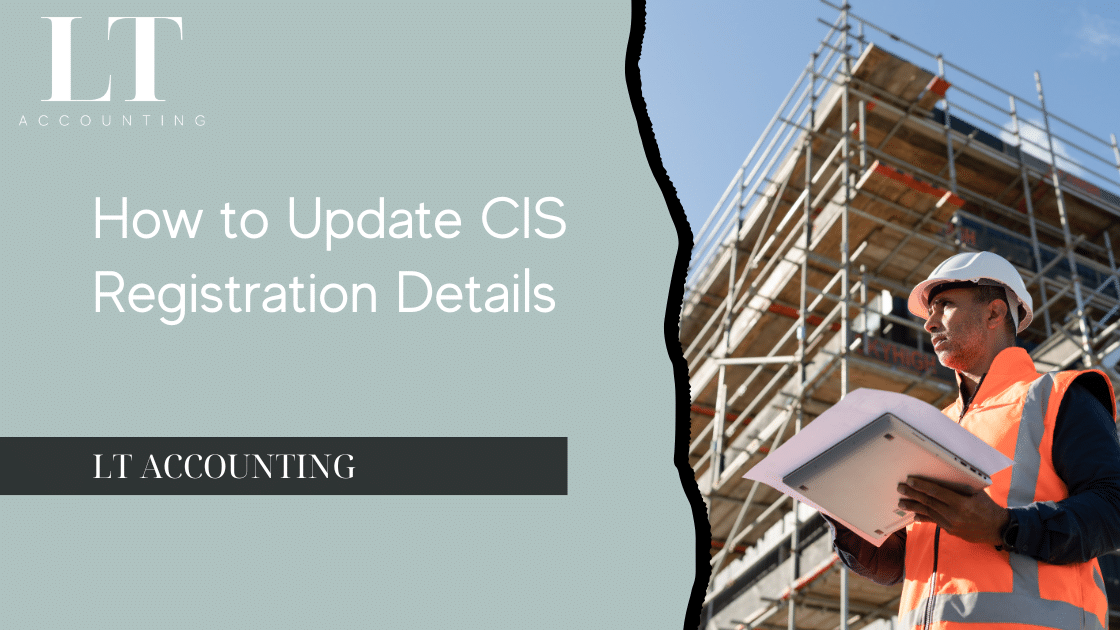The Construction Industry Scheme (CIS) is a critical part of the UK tax system, specifically designed for businesses in the construction industry. It dictates how contractors must handle payments to subcontractors and ensures that tax deductions are made correctly before payments are issued. Both contractors and subcontractors who operate under the scheme must register with HMRC.
Once registered, it’s essential to ensure that all the details you’ve provided remain up to date. Whether you’ve changed your business address, updated your contact details, or restructured your business, it’s your responsibility to update your CIS registration details with HMRC. Failing to do so could result in incorrect tax deductions, penalties, and delayed payments—all of which can disrupt your business operations.
In this article, we’ll walk you through the process of updating your CIS registration details, discuss the legal implications of inaccurate information, and explain how LT Accounting can support you in staying compliant with CIS regulations.
Understanding CIS and Registration Requirements
The Construction Industry Scheme (CIS) is a set of rules that contractors must follow when paying subcontractors for construction work. Under the scheme, contractors are required to deduct money from a subcontractor’s payments and pass it to HMRC, which counts towards the subcontractor’s tax and National Insurance contributions. Subcontractors, on the other hand, need to ensure that their registration details are correct to avoid any issues with the deductions being made.
Who needs to register under CIS?
- Contractors: Businesses or individuals that pay subcontractors for construction work.
- Subcontractors: Businesses or individuals who carry out construction work for contractors.
During the registration process, you will typically need to provide key business details such as your company name, business address, Unique Taxpayer Reference (UTR), National Insurance number, and contact information. Contractors also need to verify the details of their subcontractors through HMRC before making payments to ensure the correct tax deduction rates are applied.
Given the nature of the construction industry, business details can change frequently. You might move offices, change contact details, or even restructure your business. It’s crucial to update these details with HMRC as soon as they change, to ensure your CIS records remain accurate and to avoid any potential penalties or tax issues.
Why You Need to Update CIS Registration Details
Maintaining up-to-date CIS registration details is not just a formality; it is a legal requirement. Outdated or incorrect information can have serious repercussions for both contractors and subcontractors. Let’s explore some of the key reasons why keeping your details accurate is essential:
- Legal Compliance: HMRC requires that all businesses registered under the CIS provide accurate and current details. Failing to update your registration details can lead to fines or other legal consequences.
- Correct Tax Deductions: CIS deductions are calculated based on the information provided at the time of registration. If your registration details are incorrect, it could result in wrong tax deductions being applied—either too much or too little. For subcontractors, this could lead to cash flow issues, and for contractors, it could result in penalties from HMRC.
- Avoiding Penalties: Contractors are legally responsible for deducting the correct amount of tax from their subcontractors’ payments. If your CIS registration details are incorrect, you could face penalties for misreporting or deducting the wrong amount of tax.
- Ensuring Timely Payments: Subcontractors rely on timely payments from contractors, and any discrepancies in CIS registration details can delay these payments. If a contractor cannot verify a subcontractor’s information due to outdated details, they might apply a higher tax deduction rate or withhold payment until the issue is resolved.
By keeping your CIS registration details up to date, you ensure that you remain compliant with HMRC’s regulations, avoid unnecessary penalties, and ensure the smooth running of your business.
Steps to Update CIS Registration Details
Updating your CIS registration details is a straightforward process, and it can typically be done online via HMRC’s platform. Below is a step-by-step guide on how to update your details:
Logging into Your HMRC Online Account
To update your CIS details, you’ll need to log into your HMRC online account. If you don’t already have an account, you’ll need to register for one. Once logged in:
- Go to the ‘Services You Can Use’ section and select ‘Construction Industry Scheme’.
- From there, choose the option to view or update your CIS details.
- You can then select the specific details you wish to amend (such as your business name, address, or contact details).
Contacting HMRC Directly
In some cases, you may need to contact HMRC directly to update certain CIS registration details. For example, if you need to change your UTR or your business type, it’s recommended to reach out to HMRC via phone or email.
- HMRC CIS helpline: 0300 200 3210 (available Monday to Friday, 8 am to 8 pm, and Saturday, 8 am to 4 pm).
- Alternatively, you can use the online form on HMRC’s website to request updates or ask for advice on updating your CIS details.
Updating Key Details
The following are examples of details you can update via your HMRC online account:
- Business Address: If you’ve relocated, it’s important to update your registered business address to ensure all correspondence from HMRC is sent to the correct location.
- Company Name: For businesses that undergo a name change, updating this detail is essential to avoid confusion or miscommunication with HMRC.
- Contact Information: Ensure that phone numbers and email addresses are up to date, especially if HMRC needs to contact you regarding your CIS registration or tax matters.
Documentation for Certain Updates
While many updates can be done online, some changes require additional documentation. For example, if you’ve restructured your business or changed its legal form (e.g., from a sole trader to a limited company), you may need to submit formal documentation to HMRC, such as a certificate of incorporation or other relevant paperwork.
Timeline for Updates to Take Effect
Once you’ve submitted your updates, it can take HMRC several days to process the changes. Typically, updates are reflected within 10 working days. It’s important to allow enough time for these updates to take effect, especially if you have upcoming tax deadlines or need to ensure timely payments to subcontractors.
Updating CIS Details for Contractors
For contractors operating within the Construction Industry Scheme (CIS), keeping registration details up to date is critical not only for compliance but also to ensure that the subcontractors you work with are taxed correctly. Any changes to your business could impact how HMRC views your role as a contractor and how you verify and deduct payments for subcontractors.
Here are some key aspects contractors need to consider when updating their CIS registration details:
Changes to Business Structure
If your business changes its structure, such as transitioning from a sole trader to a limited company, you’ll need to notify HMRC immediately. Such changes affect how you’re registered for CIS, as well as how you manage your tax obligations. When updating your CIS registration to reflect this change, be prepared to provide supporting documentation, like your certificate of incorporation or other formal business records.
Changing Your Business Address
If you relocate your business, whether it’s moving to a new office or changing your registered address, updating your CIS details is essential. HMRC will send important tax documents and correspondence to the address they have on file, and any delay in receiving these communications could lead to missed deadlines and potential penalties. Log into your HMRC account and update the business address section under CIS registration.
Updating Employee Status
As a contractor, you may hire or release staff, which can alter the way your business operates. If you bring subcontractors in-house as employees, this change needs to be reflected in your CIS registration. Similarly, if subcontractors leave your employment or their work terms change, updating HMRC is essential to ensure that the correct tax deductions continue to be made.
Re-verification of Subcontractors
If your own CIS details change significantly, such as a change in your UTR or business type, you may need to re-verify your subcontractors with HMRC. This is because contractors must ensure the correct deduction rate is applied to subcontractors, and this process is based on the contractor’s registered details. Any discrepancies could result in over- or under-deduction, which could lead to disputes or penalties.
Adjusting for Changes in Business Activities
Contractors whose scope of work expands or contracts should inform HMRC if this impacts their role within the CIS. For example, if your business begins taking on fewer subcontractors and more direct work (therefore shifting away from a contractor role), HMRC needs to be aware of these changes.
By ensuring all of your contractor-related details remain accurate, you safeguard your business from potential legal issues and help maintain smooth relationships with subcontractors. Regularly reviewing and updating these details is crucial for your ongoing CIS compliance.
Updating CIS Details for Subcontractors
Subcontractors also play a critical role in the CIS, and keeping their details up to date is just as important as it is for contractors. Incorrect details can result in the wrong tax deductions being applied, which can impact cash flow and the subcontractor’s ability to claim deductions or refunds from HMRC.
Here are the key steps and considerations for subcontractors:
Updating Your UTR or Tax Rate
If there’s an error with your Unique Taxpayer Reference (UTR) or if HMRC has you registered at the wrong CIS tax rate, updating these details is a priority. Incorrect UTRs or tax rates can lead to either too much or too little tax being deducted from your payments. If too much tax is deducted, you’ll need to reclaim this from HMRC, which can cause cash flow issues in the interim. You can correct these details by contacting HMRC or by logging into your online CIS account.
Changing Your Business Address
Like contractors, subcontractors must ensure their registered business address is accurate. If you’ve moved to a new office or updated your home address (if you’re self-employed), make sure these changes are reflected in your CIS records. Delays in updating this information could result in missing important tax documents or correspondence from HMRC, which could lead to missed deadlines or penalties.
Ensuring Accurate Payment Records
It’s essential for subcontractors to maintain accurate payment records, especially in relation to the deductions made under CIS. If your CIS registration details (like your name or UTR) are incorrect or outdated, contractors may apply the wrong tax deduction rate. This could leave you either paying too much tax or having to deal with the complexities of correcting over- or underpayments with HMRC. Regularly checking and updating your CIS details ensures you’re taxed at the correct rate and can easily access refunds if applicable.
Updating Your Contact Information
As a subcontractor, you may need to update your phone number or email address so that HMRC and contractors can reach you easily. This is particularly important if you work with multiple contractors who need to verify your details before making payments. If your contact information is out of date, payments could be delayed or contractors may apply incorrect deductions.
Keeping Your Business Type Accurate
If your business has evolved—perhaps you’ve switched from being a sole trader to forming a partnership or limited company—you’ll need to update your CIS registration details accordingly. Failure to do so could lead to significant administrative issues, such as improper tax rates being applied or your payments being withheld while the correct details are sorted out with HMRC.
Common Challenges and How to Avoid Them
Updating CIS registration details should be a straightforward process, but there are a few common challenges that contractors and subcontractors might face. Here are some potential issues and tips for avoiding them:
Difficulties Accessing the HMRC Online System
Some users may experience problems logging into their HMRC online account, especially if it’s been a while since they last accessed it. In such cases, resetting your password or updating your login credentials can resolve access issues. It’s also important to keep your Government Gateway ID secure and accessible to avoid delays.
Errors in Submitting Updates
When updating details, it’s essential to double-check the accuracy of the information being submitted. Simple mistakes, such as a typo in your UTR or business address, could lead to further complications down the line. Always review your changes carefully before submitting them to HMRC.
Processing Delays
While most updates are processed within a few days, there may be occasions where HMRC takes longer to reflect changes in your account. This could delay payments or lead to incorrect deductions being applied in the meantime. To mitigate this risk, it’s a good idea to update your CIS details well in advance of any payment deadlines or contract agreements.
Not Updating All Relevant Details
Sometimes, contractors or subcontractors may update one part of their CIS registration (such as their business address) but forget to update other related details (like their contact number or email). To avoid this oversight, create a checklist of all the key information that needs to be updated and review it thoroughly.
Missing Paperwork
Certain updates, like changes to your business structure, require supporting documentation. Ensure you have all necessary paperwork ready before contacting HMRC to update your details. Missing documents could cause significant delays in processing your request.
What to Do if Your CIS Details Are Incorrect
Mistakes can happen during the registration process, or your business circumstances may have changed without your CIS details being updated. If you find that your CIS registration details are incorrect, it’s important to take immediate steps to correct the information:
Contacting HMRC
If you realise that any of your registration details are incorrect, you should contact HMRC as soon as possible. You can use the CIS helpline or the HMRC online services portal to make corrections. If the error is urgent—such as an incorrect UTR leading to wrong tax deductions—calling HMRC directly is often the quickest way to resolve the issue.
Correcting Over-Deductions
If incorrect CIS details have led to over-deductions on your subcontractor payments, you can claim a refund through HMRC. The process may involve submitting additional documentation to prove the overpayment, so be sure to keep thorough records of all payments and deductions made.
Correcting Under-Deductions
For contractors, under-deducting tax due to incorrect subcontractor details could lead to penalties from HMRC. If you discover that incorrect information has led to under-deductions, inform HMRC immediately to correct the oversight and make any necessary payments to cover the shortfall.






